|

On eBay Now...
MF4 WWII WW2 109 Sqn RAF Pathfinder cover signed WILLIS DSO DFC For Sale

When you click on links to various merchants on this site and make a purchase, this can result in this site earning a commission. Affiliate programs and affiliations include, but are not limited to, the eBay Partner Network.

MF4 WWII WW2 109 Sqn RAF Pathfinder cover signed WILLIS DSO DFC:
$11.38
60th Anniversary of the formation of the Pathfinder Force signed by Air Commodore Vic Willis DSO OBE DFCTo mark the 60th Anniversary of the formation of the Pathfinder Force, which later became No 8 Group, we have produced aspecial commemorative cover. The cover artwork shows the four initial Pathfinder squadrons; No 7 Squadron with equipped with Short Stirlings, No 35 Squadron with the HP Halifax, No 83 equipped with the Avro Lancaster and No 156 Squadron with the Vickers Wellington. The artwork shows No 7, 83 and 156 Squadrons on the first Pathfinder Raid on their way to mark and bomb Flensburg on the 18/18 August 1942, while the bottom half of the artwork shows a Halifax of No 35 Squadron being prepared. Although the initial raid was not a great success, given the very limited preparation and training of the newly formed force, however the Pathfinder Force was to prove an extremely important part of Bomber Command during the remainder of the war. Each cover bears a British Forces Post Office special handstamp, dated the 15 August 2002, which shows the Pathfinder Badge and No 8 Group logo to and commemorate the 60th Anniversary of the formation of the Pathfinder Force. Furthermore the covers have been flown in Lancaster PA474 of the Battle of Britain Memorial Flight in a flypast over RAF Wyton, the Pathfinders HQ.This cover has beenhandsigned byAir Commodore Vic Willis DSO OBE DFC, who flew Vickers Wellingtons with No 109 Squadron in the early days of delveloping Pathfinder techniques and later specialised in Radio Counter-Measures (RCM) which was a very hazardous occupation within the RAF. An extremely RAF career. Air Commodore C.V.D. Willis DSO OBE DFC
Flight Lieutenant Charles Willis served with No 109 Squadron flying Wellingtons in 1941/1942 and was awarded an immediate DFC. In 1942 he joined No 1474 Flight, a specialist radio counter-measures (RCM) unit and stayed with it when it became No 162 Squadron on 4 January 1943. In November 1943 he joined the newly formed 100 (Bomber Support) Group. Numbered and certified on reverse. His obituary from the telegraph reads: Air Commodore Vic Willis, who has died aged 89, was twice decorated for gallantry for his operational flying in the top secret world of signals intelligence, radio countermeasures and electronic warfare. In late October 1941 Willis was the pilot of one of six specially equipped Wellington bombers sent to the Middle East to provide electronic countermeasures in support of the expected offensive in the Libyan Desert. The objective was to try and jam communications on the 28 to 34 megacycles waveband used between enemy armoured columns. Operating from an advanced landing ground, the first sortie over the Sidi Omar area on November 20 satisfactorily caused a breakdown of tank-to-tank communications. The following day two Wellingtons took off for the Fort Capuzzo area. Willis was the pilot of one; the other, with the Army\'s top specialist in radio countermeasures on board, was lost. Fifteen minutes after starting the jamming operation, three Italian fighters pounced on Willis\'s lone aircraft. One of the fighters was shot down but the Wellington was severely damaged with its rear gun turret put out of action and some members of the crew wounded. Willis managed to escape into a patch of cloud and eventually limp back to base where it was discovered that his aircraft was damaged beyond repair. A few days later, again flying alone deep over enemy occupied territory, his aircraft was attacked by a German fighter. His gunners damaged the enemy and drove it off. Willis completed his task of jamming the enemy communications despite damage to his aircraft. Shortly afterwards it was announced that he had been awarded an immediate DFC. The son of the regimental sergeant-major of the Duke of Cornwall\'s Light Infantry, Charles Victor Douglas Willis was born on November 11 1916 at Calbourne, on the Isle of Wight. He was educated at Bodmin County School in Cornwall. In September 1933 he joined the RAF as an apprentice engine fitter at Halton where he excelled, finishing third in the order of merit and top in educational studies. As a result of his success, he was awarded a cadetship to the RAF College Cranwell where he was awarded the King\'s Medal for passing out first in the order of merit. He was assessed as the best pilot in his entry, being awarded the J A Chance Memorial Prize, and he also excelled at sport gaining his colours at hockey and soccer. Willis initially flew London and Sunderland flying boats with No 201 Squadron and he also fulfilled the duties of squadron adjutant. At the outbreak of war, the squadron was based at Shetland and flew patrols over the North Sea and to the Norwegian coast searching for surface raiders. In July 1940 he joined the recently formed Blind Approach and Training Development Unit at Boscombe Down. He was the source of some amusement for the other pilots who speculated on how long it would be before the former flying boat pilot committed the unforgiveable and landed with his wheels retracted - he never did. Willis was one of the initial group of pilots who investigated invisible beams that guided German bombers to their targets in the summer of 1940. These flights had to be undertaken during periods of enemy activity and often under hazardous flying conditions in order to gather the essential data for scientific analysis of the Knickebein beam. The data Willis and his colleagues gathered formed the principle for the development of blind landing techniques based on the German Lorenz beam. This in turn became the basis of the ground-controlled blind-bombing system called Oboe. After the experimental unit was re-designated No 109 Squadron Willis was made a flight commander with particular responsibility in the early development of Oboe. Such a revolutionary device inevitably suffered setbacks but, in due course, it became the primary blind-bombing aid used by Bomber Command\'s Pathfinder Force to pinpoint targets and achieve previously unattainable bombing accuracies. After his encounter with fighters over the desert, Willis remained in the Middle East and joined the newly-formed No 162 (Special Signals) Squadron at Kabrit in Egypt. Flying Wellingtons, the squadron investigated and jammed enemy radio signals. Willis flew sorties over Greece and Crete to determine the nature of the defences before another series of sorties to jam the radios of enemy tanks in the Western Desert. As the campaign in Greece finished, Willis and his crews transferred their attention to the location and jamming of radar installations at Benghazi and Derna. Willis rejoined No 109 in June 1942 just as the squadron started to train for Oboe operations with the Mosquito. By the end of the year he was promoted to wing commander when he was ordered to form a new squadron, No 192, whose role was to conduct exploratory flights over enemy territory to identify radars and the operating wavelengths used. Flying just off the coast, the data was gathered enabling counter-measures to be developed. Willis flew many sorties over the North Sea and the Bay of Biscay, but by early 1944 his Halifax and Wellington aircraft flew in support of the bomber streams gathering signals information and jamming enemy night-fighter frequencies. During the night of the Normandy invasion, Willis and his crews flew along the English Channel gathering signals information. After 18 months in command, and on continuous operations, Willis was awarded the DSO. He was described as a fine leader, whose example of courage and devotion to duty had been worthy of the greatest praise. Promoted to group captain in November 1944, Willis assumed command of RAF Foulsham the home of No 192 Squadron and other specialist radio countermeasure squadrons. In addition to his decorations, he was twice mentioned in dispatches (1941 and 1945). After the war he continued to work in the secret world of signals and spent two years commanding the flying operations of the Central Signals Establishment. In December 1948 he joined the RAF Mission in Greece where he spent the next two years at a particularly difficult time in Greek politics. He was appointed OBE. After a period instructing at the RAF Staff College, Bracknell and on the air staff at Headquarters Bomber Command, Willis was appointed the senior air staff officer at the Central Reconnaissance Establishment. He then commanded RAF Luqa, the large airfield in Malta and home to two reconnaissance squadrons that monitored the movements in the Mediterranean of the Soviet Black Sea Fleet. On promotion to air commodore in September 1962, he was appointed as commandant of the RAF Staff College at Andover before retiring in March 1965. Willis became the chairman of the West Midland Engineering Employment Association and sat on numerous industrial tribunals in the Midlands. He was a very fine squash player and represented the RAF for a number of years. He remained competitive until his early sixties. We usually have lots of other items up for sale so why not have a look

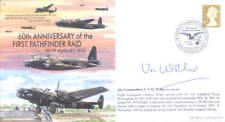
MF4 WWII WW2 109 Sqn RAF Pathfinder cover signed WILLIS DSO DFC $11.38
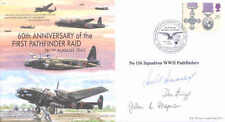
MF4 WW2 WWII RAF Pathfinder Avro Lancaster DFC DFM signed cover $11.38
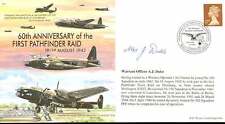
MF4 WW2 WWII RAF Vickers Wellington Pathfinder cover signed DUKE $12.01
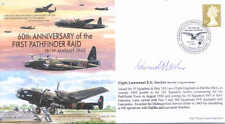
MF4 WW2 WWII RAF Pathfinder Halifax cover signed STOCKER DSO DFC $12.01

MF4b WWII WW2 RAF 1st Pathfinder Raid PFF cover signed PATRICK DFC 582 Sqn $11.38
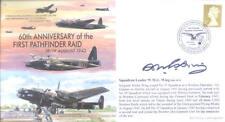
MF4 WW2 RAF Handley Page Halifax 1st Pathfinder Raid cover signed WING DFM $12.01
|